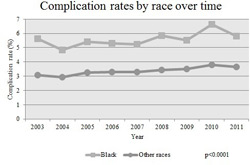
|
 |
Back to 2014 Annual Meeting Posters
Appendicitis in the Modern Era: Universal Problem and Variable Treatment
Catherine J. Yang*, Lindsay a. Bliss, Tara S. Kent, Sing Chau NG, Jonathan F. Critchlow, Jennifer F. Tseng
Surgical Outcomes Analysis and Research, Beth Israel Deaconess Medical Center, Boston, MA
Background: Acute appendicitis is the second most common gastrointestinal diagnosis mandating urgent operation in the U.S. The current state of adult appendectomy, including patient and hospital characteristics, complications, and costs are unknown.
Methods: Retrospective review of U.S. Nationwide Inpatient Sample 2003-2011 for appendectomy in ≥18 year olds. Key patient demographics and hospital characteristics, including teaching status and hospital surgical volume, were identified. The use of laparoscopy was quantified. Outcome measures included postoperative complications (primary outcome), length of stay, and patient mortality. Categorical variables were analyzed by χ2, trend analyses by Cochran-Armitage. Multivariable logistic regression was performed for adjusted predictors of developing complications.
Results: 1,663,238 weighted appendectomy discharges occurred during 2003-2011. Mean age was 40.9 (range 18-106), median Elixhauser comorbidity score was 0 (IQR 0-1), 45.3% were female, 54.6% were white. Over the period of the study, overall mortality decreased from 0.14% to 0.09% (p<0.0001), complications increased, 3.2% to 3.8% (p<0.0001), mean LOS decreased, 3.1 to 2.6 days (p<0.0001), and proportion of laparoscopic appendectomy increased, 40.9% to 75.4% (p<0.0001). In addition, patients were increasingly older (≥65 years, 9.4% to 11.6% [p<0.0001]), obese (3.8%-8.9% [p<0.0001]), and with more comorbidities (Elixhauser score ≥3, 4.7% to 9.8 % (p<0.0001) over time. After adjustment, independent predictors for postoperative complications included male sex (OR 1.6; 95% CI 1.5-1.6), black race (vs. white: OR 1.5; 95% CI 1.4-1.6), perforated appendix (OR 2.8; 95% CI 2.7-3.0), open appendectomy (OR 1.4; 95% CI 1.4-1.5), greater comorbidity (Elixhauser ≥3 vs. 0, OR 11.3, 95% CI 10.5-12.1), non-private insurance status (vs. private: Medicaid OR 1.3, 95% CI 1.2-1.4; Medicare OR 1.7, 95% CI 1.6-1.8), increasing age (>52 years vs. ≤27: OR 1.3; 95% CI 1.2-1.4) and hospital volume (vs. high: low OR 1.2; 95% CI 1.1-1.3).
Conclusions: In the present era, appendicitis remains a major source of health care utilization. Black patients and patients with public insurance have inferior outcomes to their white, privately insured peers. Laparoscopic appendectomy is increasing with decreasing mortality and length of stay, but not decreasing complications. Laparoscopy is unevenly deployed across patient groups. In the era of health care reform, careful attention to maximizing outcomes for common problems will be critical.

Back to 2014 Annual Meeting Posters
|


